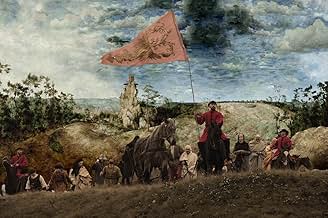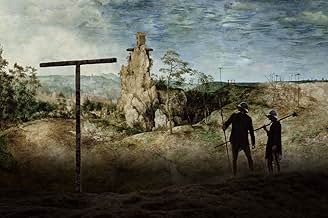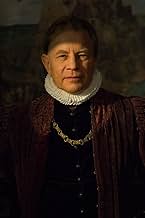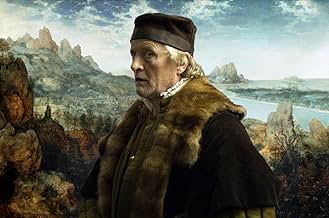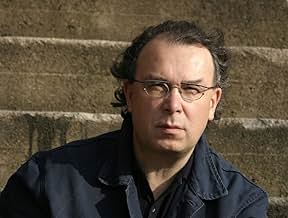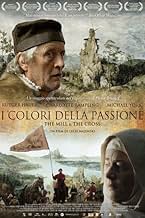NOTE IMDb
6,9/10
4,6 k
MA NOTE
Ajouter une intrigue dans votre langueThis movie focuses on a dozen of the five hundred characters depicted in Bruegel's painting. The theme of Christ's suffering is set against religious persecution in Flanders in 1564.This movie focuses on a dozen of the five hundred characters depicted in Bruegel's painting. The theme of Christ's suffering is set against religious persecution in Flanders in 1564.This movie focuses on a dozen of the five hundred characters depicted in Bruegel's painting. The theme of Christ's suffering is set against religious persecution in Flanders in 1564.
- Réalisation
- Scénaristes
- Stars
- Récompenses
- 10 victoires et 7 nominations au total
6,94.5K
1
2
3
4
5
6
7
8
9
10
Avis à la une
True gem!
I really like when the come out with a film like this. I like costume dramas, but this one is so interesting because it was made based on a painting and it works with a very interesting subject of Protestantism in Flanders and tryouts of Spanish militia to eradicate it. Not a lot of the films was made about the subject, and it clearly shows desperation of the Spanish militia to eradicate, at that time, very strong Protestant movement in Flanders. How state of the affairs came to that? I would track it down to Pope Alexander VI Borgia and total corruption of the Curria of the late 1490s. It was inevitable that someone like Martin Luther to show up, and it was a downhill for the northern Europe from that time onwards as far as Roman Catholicism.
Beside that, cinematography is great and costimography as well. True holiday for the eyes. I enjoyed every moment of it.
Beside that, cinematography is great and costimography as well. True holiday for the eyes. I enjoyed every moment of it.
A Painting Come to Life
The Mill and the Cross is a painting (so not a lot of plot!) come to life and it is unlike any movie I have ever seen before (and I have seen a few)! Directed by Polish filmmaker, Lech Majewski, it is a recreation and interpretation of the famous 1564 painting by Pieter Bruegel, "The Way to Calvary".
Glacially-paced and nearly-silent (at first) ... one film critic (Stephen Cole of "Globe and Mail") said that this film's detractors will likely lament that watching this "is like watching a painting dry" (a point I can understand some having). If it doesn't grab one's interest early-on -- the film's opening is the painting coming to life and than slowly drying back onto the canvas -- there is no point in watching it.
Another film about the inspiration of a painting (that I loved) -- The Girl with the Pearl Earring -- told a possible story of how a Vermeer masterpiece came into being AND each scene was as lovely as a painted picture. Here each scene looks like a painting as well; but this story isn't necessarily one about a "what-if" (although as a film it technically is). Instead, The Mill and the Cross pretends to show us THIS painting (not the inspiration behind it) as it is being painted.
The painting is of the re-imagined crucifixion of Christ in 16th Century Flanders while the region is under BRUTAL Spanish occupation. As Bruegel (Rutger Hauer - Batman Begins, Hobo with a Shotgun, Blade Runner) draws and explains his painting, the scene comes to life so that the audience sees what Bruegel "sees". The premise and style are highly unusual but I appreciated the delicate take (layer-upon-layer of computer imaging) of telling this story.
The Mill and the Cross isn't content with looking at a piece of art -- this film is about experiencing it which is rather marvelous as the Flanders countryside comes to life (and it is as if the audience has stumbled upon the same setting/scene as Bruegel). We get bits and pieces of story but no major plot other than the painting and its scenes/images coming to life.
This wasn't a favorite of mine by any means; but I do like the originality of it and anybody with a serious interest in art might want to check it out.
Glacially-paced and nearly-silent (at first) ... one film critic (Stephen Cole of "Globe and Mail") said that this film's detractors will likely lament that watching this "is like watching a painting dry" (a point I can understand some having). If it doesn't grab one's interest early-on -- the film's opening is the painting coming to life and than slowly drying back onto the canvas -- there is no point in watching it.
Another film about the inspiration of a painting (that I loved) -- The Girl with the Pearl Earring -- told a possible story of how a Vermeer masterpiece came into being AND each scene was as lovely as a painted picture. Here each scene looks like a painting as well; but this story isn't necessarily one about a "what-if" (although as a film it technically is). Instead, The Mill and the Cross pretends to show us THIS painting (not the inspiration behind it) as it is being painted.
The painting is of the re-imagined crucifixion of Christ in 16th Century Flanders while the region is under BRUTAL Spanish occupation. As Bruegel (Rutger Hauer - Batman Begins, Hobo with a Shotgun, Blade Runner) draws and explains his painting, the scene comes to life so that the audience sees what Bruegel "sees". The premise and style are highly unusual but I appreciated the delicate take (layer-upon-layer of computer imaging) of telling this story.
The Mill and the Cross isn't content with looking at a piece of art -- this film is about experiencing it which is rather marvelous as the Flanders countryside comes to life (and it is as if the audience has stumbled upon the same setting/scene as Bruegel). We get bits and pieces of story but no major plot other than the painting and its scenes/images coming to life.
This wasn't a favorite of mine by any means; but I do like the originality of it and anybody with a serious interest in art might want to check it out.
At the time when everything was not still.
An art movie about the 16th century's arts. It was based on the book of the same name which details the landscaper Pieter Bruegel's painting 'The Procession to Calvary'. A movie specially made for classical painting lovers.
The movie had very less talkings and everything should be learnt by watching the pictures which depicts painting like series of frames. So there's nothing much to talk about the movie. One of the best ever production designs. Frankly, I was less enjoyed due to lack of knowledge about Bruegel, but glad I saw it and come to know few things about 1500s culture through his paintings.
After all, I was not stranger to 'The Procession to Calvary' only by a few weeks before watching this movie. Recently I saw a movie called 'Museum Hours' and it helped a bit to understand this movie. In that movie a guide, an expert briefs in a scene about this painting and the reason behind it.
It was a very unique movie, which still won't exactly portray as it had happened. A glimpse about the idea of it might have been like that. More like an imaginary world created behind the magnificent art work. Not suitable for all, especially those who watch movies for entertainment should stay away from it.
The movie had very less talkings and everything should be learnt by watching the pictures which depicts painting like series of frames. So there's nothing much to talk about the movie. One of the best ever production designs. Frankly, I was less enjoyed due to lack of knowledge about Bruegel, but glad I saw it and come to know few things about 1500s culture through his paintings.
After all, I was not stranger to 'The Procession to Calvary' only by a few weeks before watching this movie. Recently I saw a movie called 'Museum Hours' and it helped a bit to understand this movie. In that movie a guide, an expert briefs in a scene about this painting and the reason behind it.
It was a very unique movie, which still won't exactly portray as it had happened. A glimpse about the idea of it might have been like that. More like an imaginary world created behind the magnificent art work. Not suitable for all, especially those who watch movies for entertainment should stay away from it.
5lixy
Gorgeous but flat and clunky
This gorgeous reconstruction of Bruegel's painting is ultimately more impressive than inspiring. There is no character, no narrative, no emotion in this piece and there's not that much analysis, either, despite the director's claims. I just saw it at the SF Film Fest, and the likable and knowledgeable director gave a lengthy lecture a) on how long it took to find the fabric for the costumes and b) on the loss of our ability to read pictorial symbols. Sadly, the latter was not related to (or within) the film directly--that would have been interesting indeed!--and neither is the impressive (expensive) production design enough to make this work compelling.
If you are interested in symbology and art history, see Peter Greenaway's, far superior Nightwatching, a film with a plot and lively characters as well as a fascinating view into the meanings (and the USE of meanings and symbols) of another famous Dutch painting, which, despite also suffering from some bombastic elements, still manages to engage the viewer in its own right as a movie.
Also Derek Jarman's Caravaggio comes to mind as a film that uses tableaux to evoke the painter of the title. Despite--or perhaps due to--being somewhat opaque and strange, the Greenaway and Jarman films (and almost any of their work) are far more interesting than The Mill and the Cross, because they use the medium of film to SHOW and not TELL. This literal and slavish reproduction of the painting was impressive in its verisimilitude but ultimately pointless and superficial.
If you are interested in symbology and art history, see Peter Greenaway's, far superior Nightwatching, a film with a plot and lively characters as well as a fascinating view into the meanings (and the USE of meanings and symbols) of another famous Dutch painting, which, despite also suffering from some bombastic elements, still manages to engage the viewer in its own right as a movie.
Also Derek Jarman's Caravaggio comes to mind as a film that uses tableaux to evoke the painter of the title. Despite--or perhaps due to--being somewhat opaque and strange, the Greenaway and Jarman films (and almost any of their work) are far more interesting than The Mill and the Cross, because they use the medium of film to SHOW and not TELL. This literal and slavish reproduction of the painting was impressive in its verisimilitude but ultimately pointless and superficial.
10shunder
A lusciously disconcerting work
It can be said that Lech Majewski's 2011 film depicts "art imitating life, imitating art, imitating life, which also typifies the layer upon layer of meaning and implication to be found in the film. Pieter Bruegel the Elder's 1564 painting "The Way to Calvary" creates the story line for this completely unconventional portrayal of life in the 1600's and Bruegel's technique or the process he may of worked through while creating the painting. Bruegal's painting is much more than a back drop and can almost be seen as a central character, perhaps even a brilliant supporting actor.
As the film weaves in and out of scenes found in the painting, the characters are brought to life portraying their personal reality behind the snippet of time in which they are actually portrayed. In a further layer in the film consider the juxtaposition of good and evil, peasants innocently awaking to begin a day's work, the musicians playing and dancing with merry abandon, contrasted with the whipping and murder of the young husband by the Spaniards. As Bruegel considers the crucifixion scene he actually begins to interact with the painting. He signals to the miller (a euphemism for God) to stop; and as the miller brings the mill (and seemingly life itself) to a standstill the moment is so unsettling as the windmill, looking mysteriously like the cross Christ has suffered on, turns counterclockwise.
The final shot in this lusciously disconcerting film pans out from the painting "The Way to Calvary" as it hangs in Kunsthistorisches Museum in Vienna, and leaves one to ponder the art each of us has seen, and the snapshots in time that art depicts. Majewski's brilliant film gives pause to consider the lives lived behind all the images of all the art over the ages, and so much more.
As the film weaves in and out of scenes found in the painting, the characters are brought to life portraying their personal reality behind the snippet of time in which they are actually portrayed. In a further layer in the film consider the juxtaposition of good and evil, peasants innocently awaking to begin a day's work, the musicians playing and dancing with merry abandon, contrasted with the whipping and murder of the young husband by the Spaniards. As Bruegel considers the crucifixion scene he actually begins to interact with the painting. He signals to the miller (a euphemism for God) to stop; and as the miller brings the mill (and seemingly life itself) to a standstill the moment is so unsettling as the windmill, looking mysteriously like the cross Christ has suffered on, turns counterclockwise.
The final shot in this lusciously disconcerting film pans out from the painting "The Way to Calvary" as it hangs in Kunsthistorisches Museum in Vienna, and leaves one to ponder the art each of us has seen, and the snapshots in time that art depicts. Majewski's brilliant film gives pause to consider the lives lived behind all the images of all the art over the ages, and so much more.
Le saviez-vous
- AnecdotesIn the movie, the two large paintings displayed behind Nicolaes Jonghelinck (Michael York) and his wife (Dorota Lis) in their house, are also works by Pieter Bruegel the Elder, "The Tower of Babel" (1563) and "Hunters in the Snow" (1565). They were indeed commissioned or at any rate owned by Jonghelinck at the time.
- GaffesA few minutes before the end of the movie, a red automobile crosses the background between two houses, while Bruegel and Nicholas Jonghelinck are speaking in the foreground.
- Bandes originalesMiserere, Opus 44
By Henryk Mikolaj Górecki
Performed by the Silesia Philharmonic Choir (Chorus Master Jan Wojtacha)
Meilleurs choix
Connectez-vous pour évaluer et suivre la liste de favoris afin de recevoir des recommandations personnalisées
- How long is The Mill and the Cross?Alimenté par Alexa
Détails
- Date de sortie
- Pays d’origine
- Site officiel
- Langues
- Aussi connu sous le nom de
- The Mill and the Cross
- Lieux de tournage
- Wieliczka, Malopolskie, Pologne(mill interiors)
- Sociétés de production
- Voir plus de crédits d'entreprise sur IMDbPro
Box-office
- Montant brut aux États-Unis et au Canada
- 312 187 $US
- Week-end de sortie aux États-Unis et au Canada
- 11 354 $US
- 18 sept. 2011
- Montant brut mondial
- 1 116 180 $US
- Durée
- 1h 32min(92 min)
- Couleur
- Mixage
- Rapport de forme
- 1.85 : 1
Contribuer à cette page
Suggérer une modification ou ajouter du contenu manquant


